Bee's Alternator
February 2025: First opportunity to get the cars out in a long time as the roads have rarely been dry and salt free for what seems like months. Enjoyed an hour in Vee but next day had to cut short Bee's trip as about 15 minutes in I noticed the digital voltmeter (originally bought to check 'smart charging' on the A-Class) was only showing just over 12v, so turned round and headed home, ignition warning light not glowing. Over half an hour it only dropped a couple of tenths, except when braking which took a couple of tenths more off so I used the handbrake where feasible. OD took another tenth off so stopped using that as well. Back home switched off, then turned the ignition on and no light! I can't swear I checked the light before cranking this trip, but I know when I have been messing around in the garage and had the ignition on over winter it's been working then. Good job I had the voltmeter, although only planning to be out for about another 20 minutes so probably would have been OK. Didn't have the lithium pack with me ... I'd thought about it but I've been keeping it in the A-Class as that has been showing the usual battery warnings and couldn't be bothered to unlock that as well and get it out! The lesson? Always check the warning light comes on with the ignition and before cranking! Not a guarantee of detecting a fault that occurs while driving unlike if the fan-belt breaks or with some alternator faults which cause the light to come on, but others won't as in this case.
Back home the alt plug shows the correct voltages engine stopped i.e. 12v on both the browns, and the brown/yellow with the ignition on so its the alt. Someone gave me this Lucas ACR18 four years ago so I fitted it to Bee which released the shorter A127 she came to me with to use as a spare for the V8 (the Lucas being too long). I also have a spare A115 from a scrapped Metro that I had previously trial-fitted and tested as a spare for Bee, albeit giving a reduced charging voltage as it has a bigger pulley, so that can go back on while I investigate the Lucas. The V8 alt is 'left-handed' whereas the MGB is 'right-handed' which meant I had to swing the front of the A127 round relative to the back to fit the V8, and I don't want to have to go through that process twice to put it back on Bee, then restore later on it for use on Vee. The warning light gets it's earth supply through the voltage regulator and field winding i.e. via the brushes, so they will be the first check, then the voltage regulator. I put the Ctek on basic charge to top the battery back up.
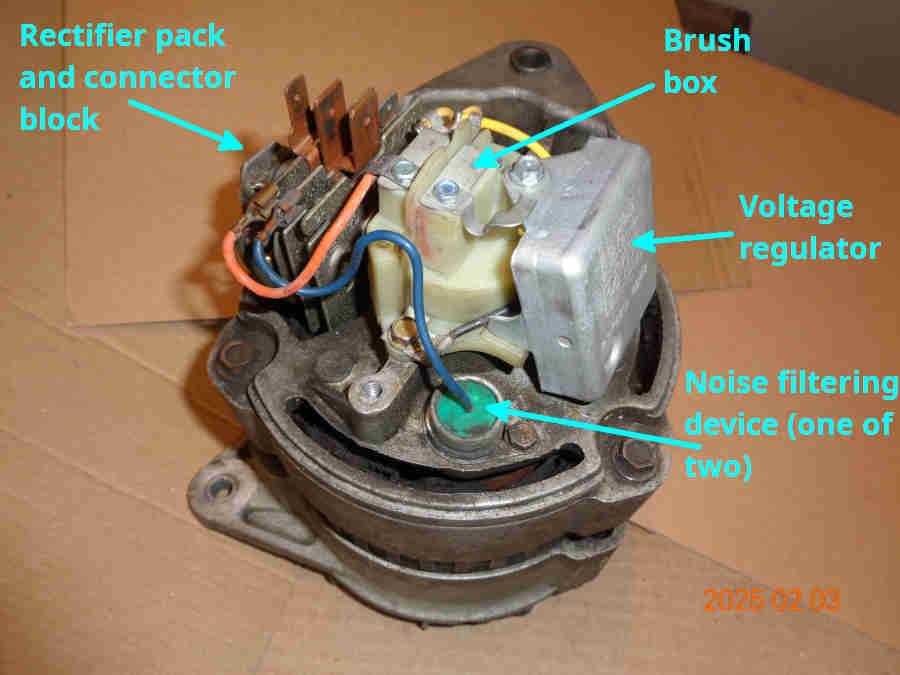 Next day the faulty one comes off and the Metro spare goes on and tested in about 45 mins - output a bit low and needed more revs to start it charging as noted previously. Got the end-cap off the 18ACR to reveal all the internal connections, and no continuity through the brushes and field winding.
Next day the faulty one comes off and the Metro spare goes on and tested in about 45 mins - output a bit low and needed more revs to start it charging as noted previously. Got the end-cap off the 18ACR to reveal all the internal connections, and no continuity through the brushes and field winding.
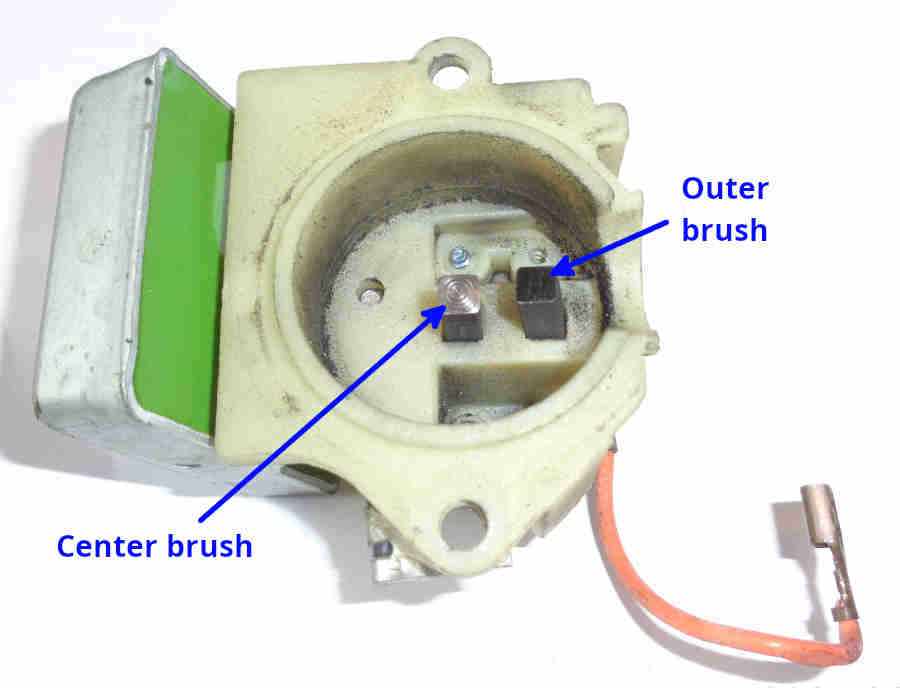
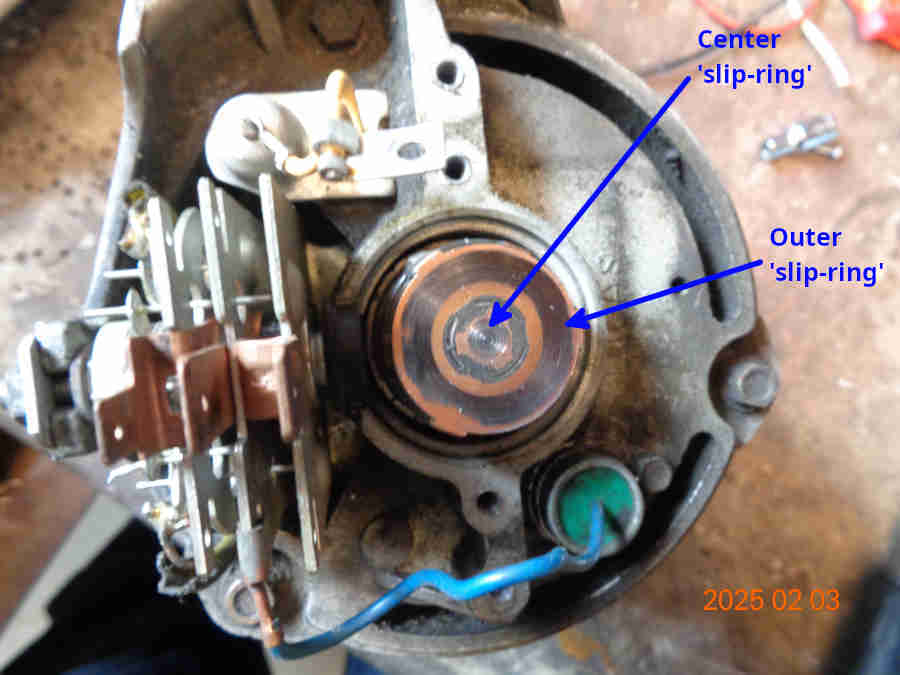 Get the brush box off and the brushes seem OK - oddly the centre one seems to be worn more than the outer one with plenty of 'meat' on them and the springs pushing the carrier off as the screws were slackened, but there is no continuity between the 'slip-rings' on the rotor! Also unexpected was finding the 'slip-rings' on the end of the rotor shaft i.e. axial rather than radial as in a dynamo.
Get the brush box off and the brushes seem OK - oddly the centre one seems to be worn more than the outer one with plenty of 'meat' on them and the springs pushing the carrier off as the screws were slackened, but there is no continuity between the 'slip-rings' on the rotor! Also unexpected was finding the 'slip-rings' on the end of the rotor shaft i.e. axial rather than radial as in a dynamo.
So the whole thing will have to be replaced. That raises the conundrum of what to replace it with and where to get it. The first replacement on pal's pal's car came without a pulley, the nut on the faulty one came off OK but we just could not get the pulley off the shaft and ended up smashing it. So another one was obtained complete with pulley. There are two sizes of pulley for the MGB - 2.75" prior to 1976 and the 16 and 17ACR, and 2.5" after that on the 18ACR, the bigger one on the Metros spare is bigger which is why it gives less output as it is spinning slower. Browsing the internet the usual suspects have 'bare' alternators but shafts and threads might be different, eBay mostly seem to come with pulleys but no indication of size. I suspect the one we ended up with on pal's pal's car had the bigger pulley which is why we had a struggle getting the correct belt on. So I wrap an old fan belt round the pulley on the faulty 18ACR, clamp it up in my vice and get my air-gun on it - no go. So a quick squirt of Holts releasing spray and try again and it spins right off. This one has a Woodruff key (unlike the A127), tapping on the exposed end of that with a hammer and blunt chisel curved it out of the slot enough to pull it out with pliers.
So now I have the option of getting a bare one - but checking to see the Woodruff key, fan, pulley and nut fit of course which makes mail-order risky. Complete is equally risky as I want a 2.5" pulley not a 2.75"! Bare from the usual suspects at around £100 plus p&p is more expensive than complete from eBay of course at around £55 but with the usual caveats about quality in the latter. If the pulley on those is the bigger one and I can't get it off then I'm stuck with it, and an enquiry to an Ebayer won't tell me what size they have only asking for Reg No. and part nos. etc. and supplying those will of course elicit the response "Yes sir, we have the correct one ...". Motaclan show a 45amp 18ACR at £81 but out of stock, or a GXE2206 17ACR equivalent at £76 complete and in stock but a bit of a trek.
 Closer are Dorridge Autos with an 18ACR complete with a 2.5" pulley for £83 so they get my custom. A wonderful place for what is basically a village shop, he joked that usually the only alts they sell are to farmers. They have been able to source some pretty esoteric stuff in the past such as TR4 ignition parts, Lola kit car relays and self-amalgamating tape when replacing its radiator. Another source of amusement was when my credit card didn't work either tapping or chip or pin. They said they would do it as 'customer not present' so I asked if I should go outside ...
Closer are Dorridge Autos with an 18ACR complete with a 2.5" pulley for £83 so they get my custom. A wonderful place for what is basically a village shop, he joked that usually the only alts they sell are to farmers. They have been able to source some pretty esoteric stuff in the past such as TR4 ignition parts, Lola kit car relays and self-amalgamating tape when replacing its radiator. Another source of amusement was when my credit card didn't work either tapping or chip or pin. They said they would do it as 'customer not present' so I asked if I should go outside ...
 A trip to Dorridge in the V8 so that's a bonus, and back just before the rain. Get the spare off and the new one on and tested. A bit longer than for the spare as there were a couple of differences - one was the alternator 'ear' is not tapped for the adjuster link bolt but a plain hole. So that needs a bolt and nut partially tightened off-car then set to the correct angle on-car, then taken off and the the nut and bolt fully tightened, as I can't get to the nut on the back of the ear. That needed a couple of iterations before the front upper bolt would go through.
A trip to Dorridge in the V8 so that's a bonus, and back just before the rain. Get the spare off and the new one on and tested. A bit longer than for the spare as there were a couple of differences - one was the alternator 'ear' is not tapped for the adjuster link bolt but a plain hole. So that needs a bolt and nut partially tightened off-car then set to the correct angle on-car, then taken off and the the nut and bolt fully tightened, as I can't get to the nut on the back of the ear. That needed a couple of iterations before the front upper bolt would go through.
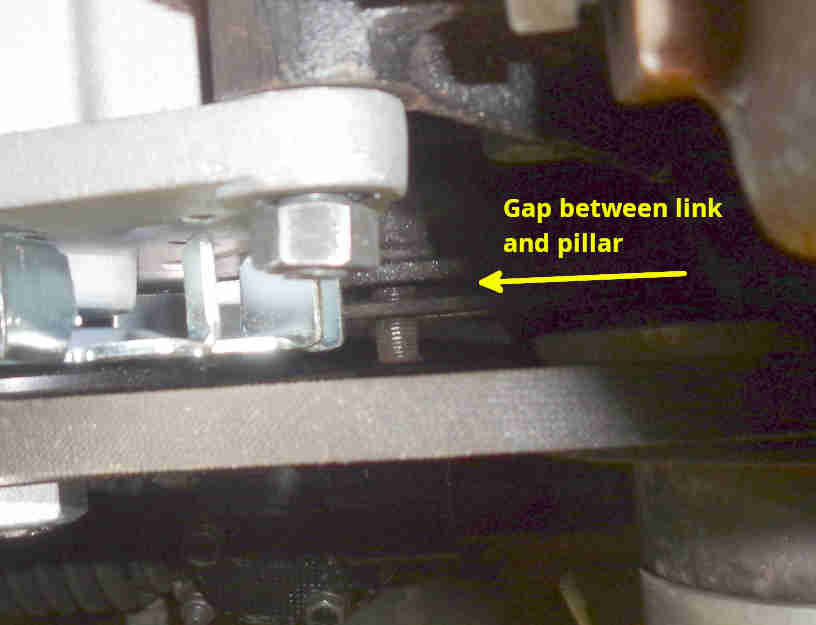 The second is that there was a thick spacer between the link and the alternator ear but with that fitted to the new alt it left a gap of a good 1/8" or more between the link and the mounting pillar on the engine, so that had to come off. I put that back on the bolt so it's there is needed again.
The second is that there was a thick spacer between the link and the alternator ear but with that fitted to the new alt it left a gap of a good 1/8" or more between the link and the mounting pillar on the engine, so that had to come off. I put that back on the bolt so it's there is needed again.
The final hurdle is that I can't get the fan belt over even the water pump pulley with the alt fitted and loose, I have to remove the upper bolts so I can angle the alt to get the belt on, checking it is still in the crank pulley groove before refitting the upper bolts, so another case of a replacement alt being fatter and can't be pushed towards the engine far enough.
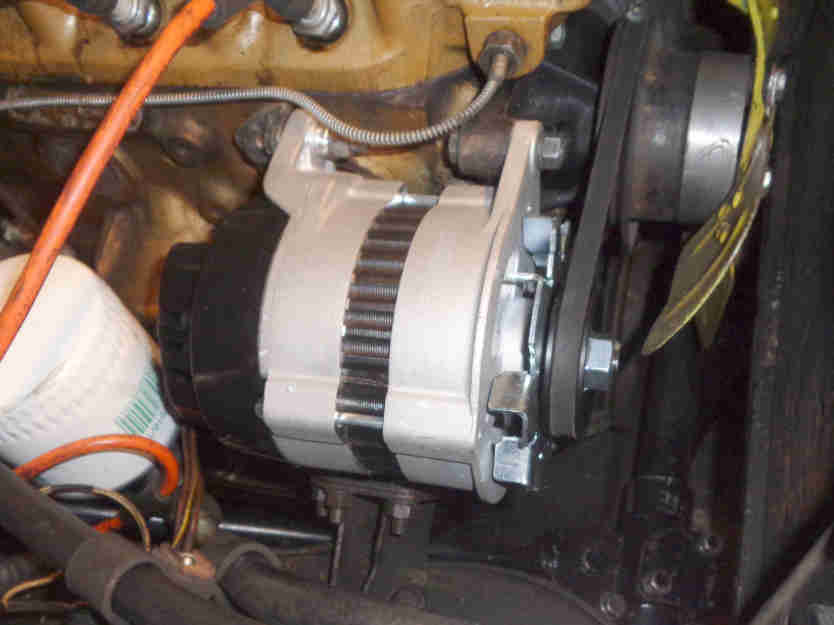 Then the usual hammer handle between block and alt to lever it out to give the correct tension while I tighten the link to pillar nut, then tighten the two top nuts and bolts, and recheck tension. Fire it up and 14.2-14.3v - a little on the low side but maybe putting charge back in the battery after running with no charge then briefly the low-output Metro. Normal running settles down to a consistent 14.4v so that's fine.
Then the usual hammer handle between block and alt to lever it out to give the correct tension while I tighten the link to pillar nut, then tighten the two top nuts and bolts, and recheck tension. Fire it up and 14.2-14.3v - a little on the low side but maybe putting charge back in the battery after running with no charge then briefly the low-output Metro. Normal running settles down to a consistent 14.4v so that's fine.
June 2025: Still charging at 14.4v on a 100-miler a few days ago but following a service (only work in the engine compartment was oil and filter change) a quick trip round the block shows it down to 14.2v which is a bit odd. Confirmed at the fusebox with another meter, so needs keeping an eye on. A bit longer run and it was going up to 14.3v, but that was local roads so no OD, and switching that in dropped to 14.2v again, and the vast majority of the 14.4v I'm used to seeing will have been with OD engaged.
I checked the voltage at the alt and the battery cable stud and that was a fraction under 14.5v, but I didn't measure that when first fitting the new alt so that may have dropped as well. It's inevitable with old wiring and connections that you will get the odd tenth dropped when a circuit is carrying current, The voltmeter is on the accessories connection so fed from the brown at the ignition switch, the OD fed from the white so also fed from the brown at the ignition switch, so the switch and the brown up from the starter and from the alt plus the alt itself are the only common factors. Confirmation that adding gauges adds things to worry about!
More checking - no drain with everything switched off; no excessive currents with things switched on; cranking volt-drops just half a volt on the 12v side from battery post to battery cable stud in the engine compartment and only 0.2v on the earth side battery post to engine. But then the starter is really spinning the engine when cranking so I didn't anticipate problems there, and in any case those circuits aren't used when the cabin voltmeter is reading the output from the alternator.
More testing and comparing the voltage at the engine compartment battery cable stud (starter cable up from the solenoid for jump-starting) on an analogue instrument with the cabin digital on the accessories circuit. Cabin 0.3v lower with nothing on, 0.75v lower with ignition on, 0.8v plus brake lights, 0.9v plus dipped headlights, and back to 0.25v lower with everything off again. The first and last readings are odd as there is no current flowing so should be no volt-drop, so put another digital instrument where the analogue is and it shows the same as the cabin meter. So about 0.25-0.3v is down to the analogue meter seemingly optimistic, although as an AVO and high quality I'd expect that to be the most accurate. Which leaves about 0.6v being 'lost' with the load of ignition, brake and main lights.
Next was to connect the cabin meter to the battery cable stud (via a fuse) which should show exactly what is coming out of the alternator. That will be subject to any volt-drops between alt and solenoid, next step would be connection direct to the alt spades - carefully as it is unfused of course! However on the battery cable stud there were only occasional variations between 14.4v and 14.5v, regardless of brake lights and headlights (the more powerful headlamp flasher this time) so the alternator is 'consistent' even if it is perhaps a bit lower than I would like, as are the connections from there to the solenoid.
I then put the meter back on the accessories circuit and even in normal running with no changes in load it was varying between 14.1v and 14.4v, so definitely something between the solenoid and the accessories output of the ignition switch. On the 73 model year the brown comes up from the solenoid to a sealed junction that has three spurs to ignition switch, fusebox (headlamp flasher) daisy-chained to the main lighting switch, and starter relay. Of those only the accessories supply comes through the ignition switch, so the variation in voltage on the accessories with load on the fusebox and main lighting switch branch has to be occurring between the solenoid and the sealed junction. The battery cable, the feed to the stud in the engine bay, the alternator wires, and the brown wire up to the sealed junction are all bolted together on the solenoid stud (unlike earlier where the brown wires were on spades on the battery cable stud) which makes poor connections between the browns and the others seem unlikely, although many years ago that connection failed during an MOT and completely stumped the workshop when a jump pack on the battery terminals did nothing! They were kind enough to let me disconnect it and clean up all four through-hole terminals while it was on their ramp.
If that wasn't enough in one out of three starts on that day there was just a clonk from the solenoid! Shades of last year. Next test is with the cabin meter connected to the brown at the fusebox which eliminates the ignition switch and its spur. Initially 14.4-14.5v, adding load sometimes made little difference and some times lights and heater fan bought it down to 13.6-13.8v, so another check of the solenoid connections is next, before an upcoming club run and our next trip to Norfolk.
In the event I decided not fiddle immediately before the club run nor the Norfolk trip to avoid triggering a problem, it can wait until later. I'll be taking a spare alt with me in any case.
 Next day the faulty one comes off and the Metro spare goes on and tested in about 45 mins - output a bit low and needed more revs to start it charging as noted previously. Got the end-cap off the 18ACR to reveal all the internal connections, and no continuity through the brushes and field winding.
Next day the faulty one comes off and the Metro spare goes on and tested in about 45 mins - output a bit low and needed more revs to start it charging as noted previously. Got the end-cap off the 18ACR to reveal all the internal connections, and no continuity through the brushes and field winding.





